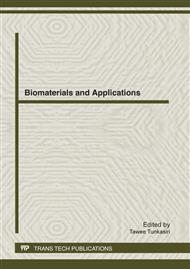p.319
p.323
p.327
p.331
p.335
p.339
p.343
p.347
p.351
In Situ Crosslinkable Thiolated Chitosan as Scaffold Material for Tissue Engineering
Abstract:
The scope of the study was to investigate the potential of thiolated chitosan as scaffold material for tissue engineering. Porous scaffolds were fabricated by freeze-drying method and stailized via disulfide bond formation. Characterizations were focused on morphological structure and degree of disulfide cross-linking. Renal proximal tubule epithelial cells (RPTECs) were used as model cell line. Chitosan-thioglycolic acid conjugate (chitosan-TGA) displayed 624.8 ± 21.2 and 1195.9 ± 61.0 µmol thiol groups/g polymer (chitosan-TGA 625 and chitosan-TGA 1196, respectively). After 4 days of incubation, the attachment of cells on the chitosan-TGA 625 and chitosan-TGA 1196 scaffolds were 101 ± 6.36 and 157.5 ± 2.82 cells/mm2, respectively. However, RPTECs did not grow on the unmodified chitosan scaffolds. These results confirm the potential utility of chitosan-TGA as a novel candidate being used as scaffold material in tissue engineering.
Info:
Periodical:
Pages:
335-338
Citation:
Online since:
April 2012
Keywords:
Price:
Сopyright:
© 2012 Trans Tech Publications Ltd. All Rights Reserved
Share:
Citation:


